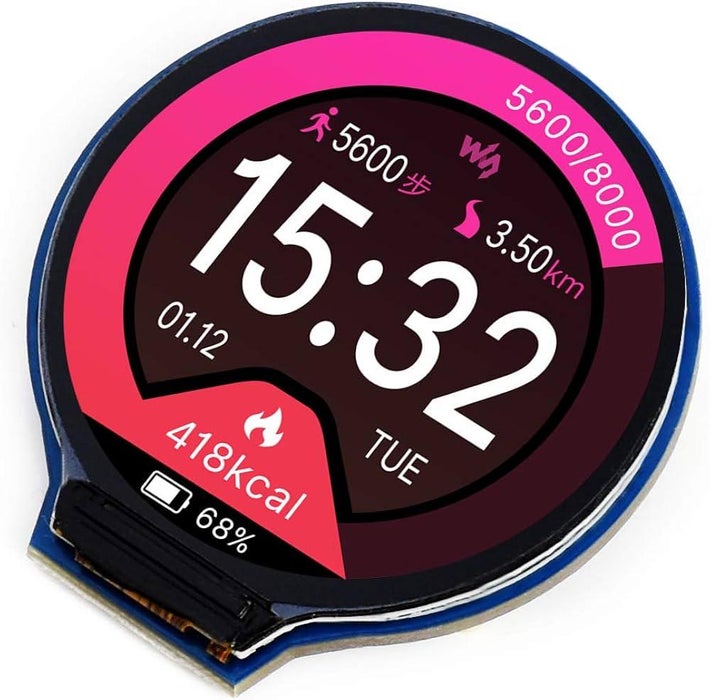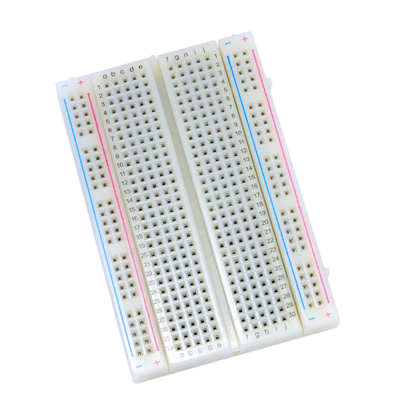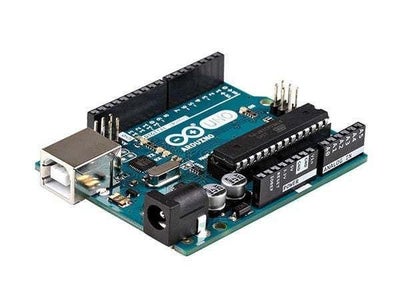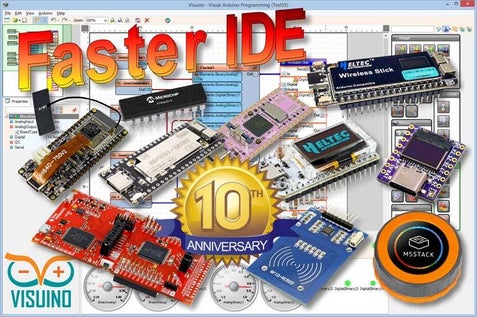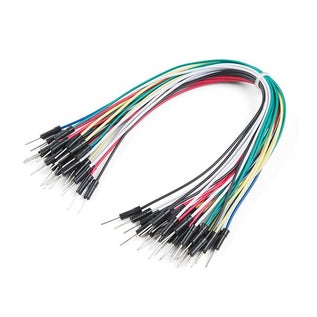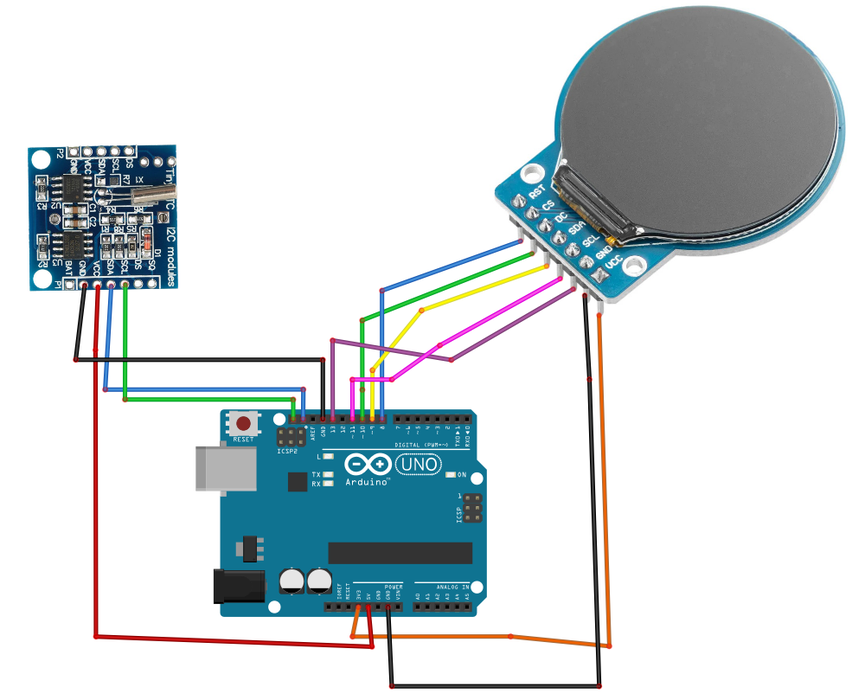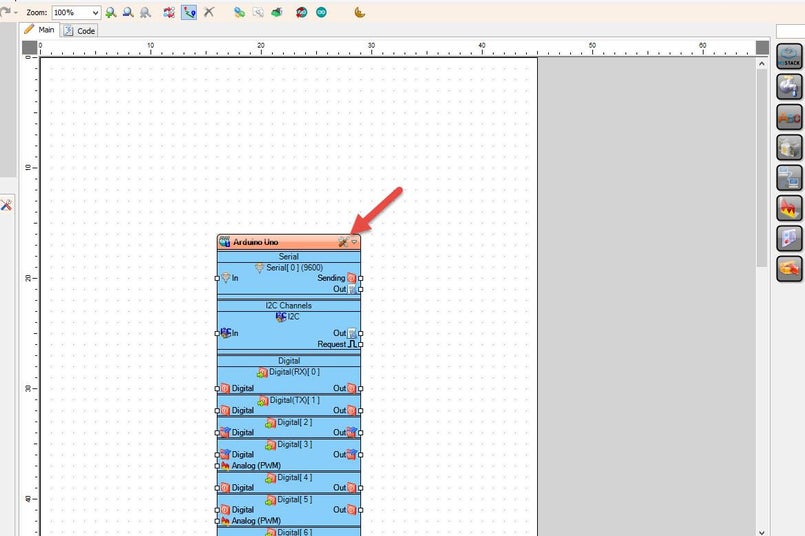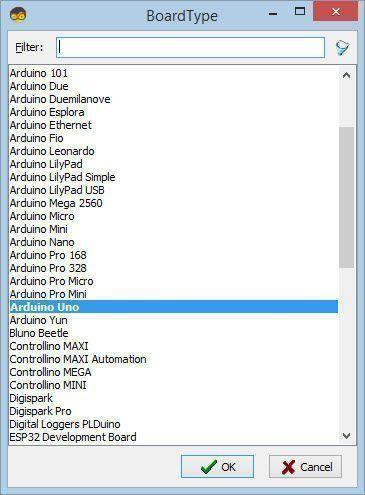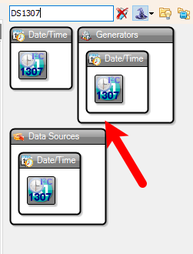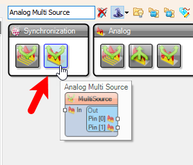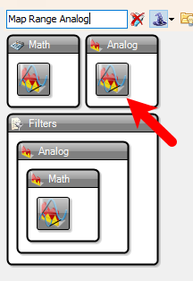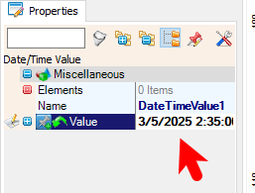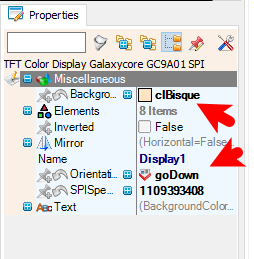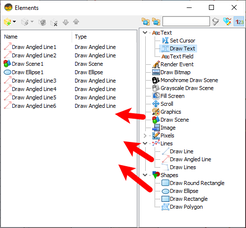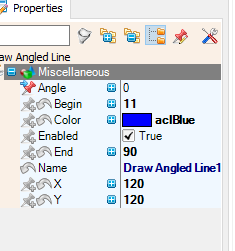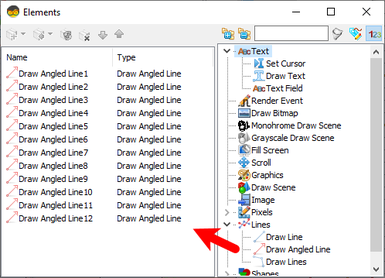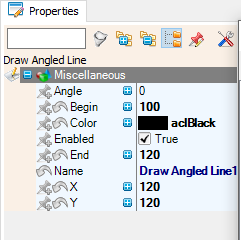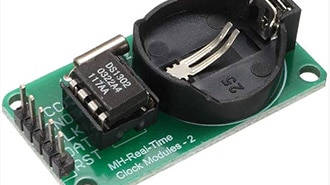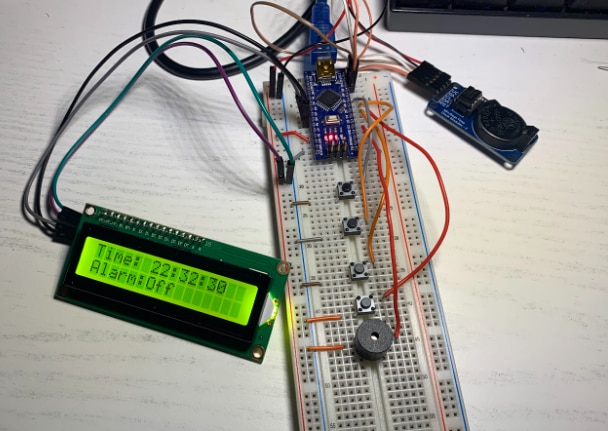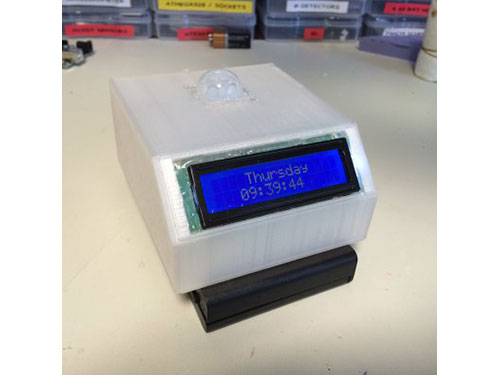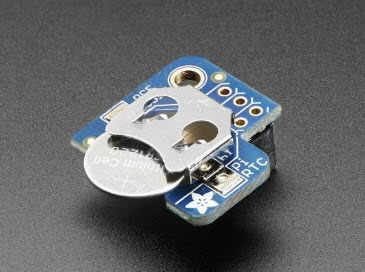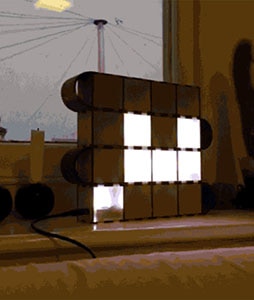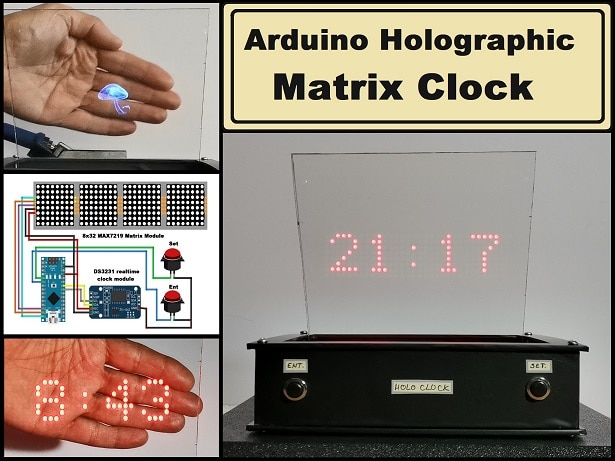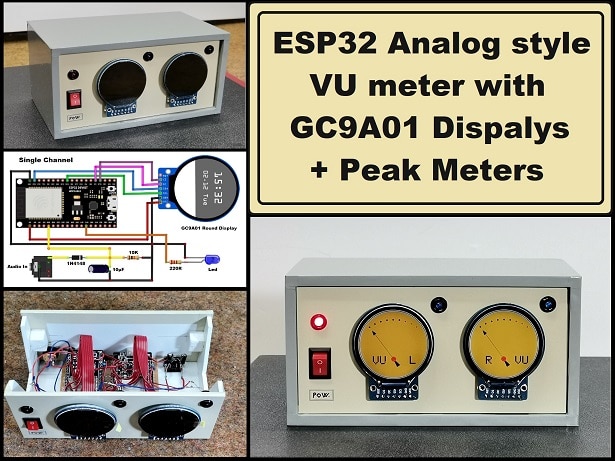Real Time Clock & GC9A01 Display Using Visuino
2025-06-04 | By Ron Cutts
License: General Public License Displays Real Time Clocks (RTCs) SPI Arduino
Step 1: What You Will Need
Arduino UNO (or any other Arduino or ESP)
Visuino program: Download Visuino
Note: If you plan to use a lot of graphics on the display or more sensor/modules, then you might need a board with larger memory like Arduino UNO R4 WiFi
Step 2: The Circuit
Connect GC9A01 Display pin [VCC] to Arduino pin [3.3V]
Connect GC9A01 Display pin [GND] to Arduino pin [GND]
Connect GC9A01 Display pin [SCL] to Arduino pin [13]
Connect GC9A01 Display pin [SDA] to Arduino pin [11]
Connect GC9A01 Display pin [DC] to Arduino pin [9]
Connect GC9A01 Display pin [CS] to Arduino pin [10]
Connect GC9A01 Display pin [RST ] to Arduino pin [8]
Connect Encoder module pin [CLK] to Arduino digital pin [2]
Connect Encoder module pin [DT] to Arduino digital pin [3]
Connect Encoder module pin [+] to Arduino pin [5v]
Connect Encoder module pin [-] to Arduino pin [GND]
Connect RTC DS1307 module pin[VCC] to Arduino pin[5V]
Connect RTC DS1307 module pin[GND] to Arduino pin[GND]
Connect RTC DS1307 module pin[SDA] to Arduino pin[SDA]
Connect RTC DS1307 module pin[SCL] to Arduino pin[SCL]
Step 3: Start Visuino, and Select the Arduino UNO Board Type
Start Visuino as shown in the first picture. Click on the "Tools" button on the Arduino component (Picture 1) in Visuino. When the dialog appears, select "Arduino UNO" as shown in Picture 2
Step 4: In Visuino Add & Set Components
Add "Date/Time Value" component
Add "DS1307" component
Add "Decode(Split) Date/Time" component
Add 3X "Analog Multi Source" component
Add 3X "Map Range Analog" component
Add "GC9A01 SPI" component
Select "DateTimeValue1" and in the properties window set under "Value" the current time & date
For all Analog Multi Source components in the properties window, set "Output Pins" to 5
Step 5: In Visuino Set the Display
Select "Display1" and in the properties window set "Background Color" to clBisque and "Orientation" to goDown
Step 1: Open the Display Configuration
Double-click on the Display1 component in the diagram.
This will open the Elements window for the display.
Drag 6X "Draw Angled Line" element to the left side
Drag "Draw Scene" to the left side
Drag "Draw Ellipse" to the left side
Step 2: Configure Graphical Elements
Draw Angled Line1:
In the Elements window, locate the Draw Angled Line1 element.
In the Properties window, configure the following:
Set Begin to 11.
Set End to 90.
Set X to 120.
Set Y to 120.
Set Color to aclBlue
Select Angle and click on the pin icon and select Float SinkPin
Draw Angled Line2:
In the Elements window, locate the Draw Angled Line2 element.
In the Properties window, configure the following:
Set Begin to 11.
Set End to 90.
Set X to 120.
Set Y to 120.
Set Color to aclBisque
Select Angle and click on the pin icon and select Float SinkPin
Draw Angled Line3:
In the Elements window, locate the Draw Angled Line3 element.
In the Properties window, configure the following:
Set Begin to 11.
Set End to 80.
Set X to 120.
Set Y to 120.
Set Color to aclBlue
Select "Angle" and click on the pin icon and select "Float SinkPin"
Draw Angled Line4:
In the Elements window, locate the Draw Angled Line4 element.
In the Properties window, configure the following:
Set Begin to 11.
Set End to 80.
Set X to 120.
Set Y to 120.
Set Color to aclBisque
Select "Angle" and click on the pin icon and select "Float SinkPin"
Draw Angled Line5:
In the Elements window, locate the Draw Angled Line5 element.
In the Properties window, configure the following:
Set Begin to 11.
Set End to 100.
Set X to 120.
Set Y to 120.
Set Color to aclRed
Select "Angle" and click on the pin icon and select "Float SinkPin"
Draw Angled Line6:
In the Elements window, locate the Draw Angled Line6 element.
In the Properties window, configure the following:
Set Begin to 11.
Set End to 100.
Set X to 120.
Set Y to 120.
Set Color to aclBisque
Select Angle and click on the pin icon and select Float SinkPin
Draw Scene1:
In the Elements window, locate the Draw Scene1 element.
In the Properties window, select Elements and click on the 3 dots button.
In the Elements window, add 12X Draw Angled Line elements.
For each Draw Angled Line element, set the properties as follows:
Draw Angled Line1:
Name: Draw Angled Line1
Properties:
Begin: 100
Angle: 0
X: 120
Color: aclBlack
End: 120
Y: 120
Draw Angled Line2:
Name: Draw Angled Line2
Properties:
Begin: 100
Angle: 30
X: 120
Color: aclBlack
End: 120
Y: 120
Draw Angled Line3:
Name: Draw Angled Line3
Properties:
Begin: 100
Angle: 60
X: 120
Color: aclBlack
End: 120
Y: 120
Draw Angled Line4:
Name: Draw Angled Line4
Properties:
Begin: 100
Angle: 90
X: 120
Color: aclBlack
End: 120
Y: 120
Draw Angled Line5:
Name: Draw Angled Line5
Properties:
Begin: 100
Angle: 120
X: 120
Color: aclBlack
End: 120
Y: 120
Draw Angled Line6:
Name: Draw Angled Line6
Properties:
Begin: 100
Angle: 150
X: 120
Color: aclBlack
End: 120
Y: 120
Draw Angled Line7:
Name: Draw Angled Line7
Properties:
Begin: 100
Angle: 180
X: 120
Color: aclBlack
End: 120
Y: 120
Draw Angled Line8:
Name: Draw Angled Line8
Properties:
Begin: 100
Angle: 210
X: 120
Color: aclBlack
End: 120
Y: 120
Draw Angled Line9:
Name: Draw Angled Line9
Properties:
Begin: 100
Angle: 240
X: 120
Color: aclBlack
End: 120
Y: 120
Draw Angled Line10:
Name: Draw Angled Line10
Properties:
Begin: 100
Angle: 270
X: 120
Color: aclBlack
End: 120
Y: 120
Draw Angled Line11:
Name: Draw Angled Line11
Properties:
Begin: 100
Angle: 300
X: 120
Color: aclBlack
End: 120
Y: 120
Draw Angled Line12:
Name: Draw Angled Line12
Properties:
Begin: 100
Angle: 330
X: 120
Color: aclBlack
End: 120
Y: 120
Close the Elements window.
Draw Ellipse1:
In the Elements window, locate the Draw Ellipse1 element.
In the Properties window, configure the following:
Set Width to 20.
Set Height to 19.
Set X to 110.
Set Y to 110.
Set FillColor to aclBlue
Set Color to aclBlue
Step 3: Connect Clock Inputs
Draw Ellipse1:
Connect the ClockInputPin to MultiSource2 pin [Pin 0], MultiSource1 pin [Pin 0], and MultiSource3 pin [Pin 0].
Draw Angled Line1:
Connect the ClockInputPin to MultiSource2 pin [Pin 4].
Draw Angled Line2:
Connect the ClockInputPin to MultiSource2 pin [Pin 1].
Draw Angled Line3:
Connect the ClockInputPin to MultiSource1 pin [Pin 4].
Draw Angled Line4:
Connect the ClockInputPin to MultiSource1 pin [Pin 1].
Draw Angled Line5:
Connect the ClockInputPin to MultiSource3 pin [Pin 4].
Draw Angled Line6:
Connect the ClockInputPin to MultiSource3 pin [Pin 1].
Step 6: In Visuino Connect Components


Connect "DateTimeValue1" pin [Out] to "RealTimeClock1" pin [Set]
Connect "RealTimeClock1" pin [I2C] to "Arduino" pin [I2C]
Connect "RealTimeClock1" pin [Out] to "DecodeDateTime1" pin [In]
Connect "DecodeDateTime1" pin [Minute] to "MapRange1" pin [In]
Connect "DecodeDateTime1" pin [Hour] to "MapRange2" pin [In]
Connect "DecodeDateTime1" pin [Second] to "MapRange3" pin [In]
Connect "MapRange1" pin [Out] to "MultiSource2" pin [In]
Connect "MapRange2" pin [Out] to "MultiSource1" pin [In]
Connect "MapRange3" pin [Out] to "MultiSource3" pin [In]
Connect "MultiSource2" pin [Pin[0]] to "Display1" pin [Elements.Draw Ellipse1.Clock]
Connect "MultiSource2" pin [Pin[1]] to "Display1" pin [Elements.Draw Angled Line2.Clock]
Connect "MultiSource2" pin [Pin[2]] to "Display1" pin [Elements.Draw Angled Line1.Angle]
Connect "MultiSource2" pin [Pin[3]] to "Display1" pin [Elements.Draw Angled Line2.Angle]
Connect "MultiSource2" pin [Pin[4]] to "Display1" pin [Elements.Draw Angled Line1.Clock]
Connect "MultiSource1" pin [Pin[0]] to "Display1" pin [Elements.Draw Ellipse1.Clock]
Connect "MultiSource1" pin [Pin[1]] to "Display1" pin [Elements.Draw Angled Line4.Clock]
Connect "MultiSource1" pin [Pin[2]] to "Display1" pin [Elements.Draw Angled Line3.Angle]
Connect "MultiSource1" pin [Pin[3]] to "Display1" pin [Elements.Draw Angled Line4.Angle]
Connect "MultiSource1" pin [Pin[4]] to "Display1" pin [Elements.Draw Angled Line3.Clock]
Connect "MultiSource3" pin [Pin[0]] to "Display1" pin [Elements.Draw Ellipse1.Clock]
Connect "MultiSource3" pin [Pin[1]] to "Display1" pin [Elements.Draw Angled Line6.Clock]
Connect "MultiSource3" pin [Pin[2]] to "Display1" pin [Elements.Draw Angled Line5.Angle]
Connect "MultiSource3" pin [Pin[3]] to "Display1" pin [Elements.Draw Angled Line6.Angle]
Connect "MultiSource3" pin [Pin[4]] to "Display1" pin [Elements.Draw Angled Line5.Clock]
Connect "Display1" pin [Chip Select] to Arduino digital pin [10]
Connect "Display1" pin [Data Command] to Arduino digital pin [9]
Connect "Display1" pin [Reset] to Arduino digital pin [8]
Connect "Display1" Control pin [SPI] to Arduino SPI pin [In]
Step 7: Generate, Compile, and Upload the Arduino Code
In Visuino, at the bottom, click on the "Build" Tab, make sure the correct port is selected, then click the "Compile/Build and Upload" button.
Step 8: Play
Congratulations! You have completed your project with Visuino. Also attached is the Visuino project that I created. You can download it here and open it in Visuino: https://www.visuino.eu
Download Visuino File: GC9A01-ds1307-rtc-CLOCK.visuino







